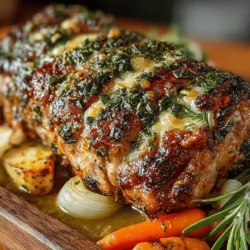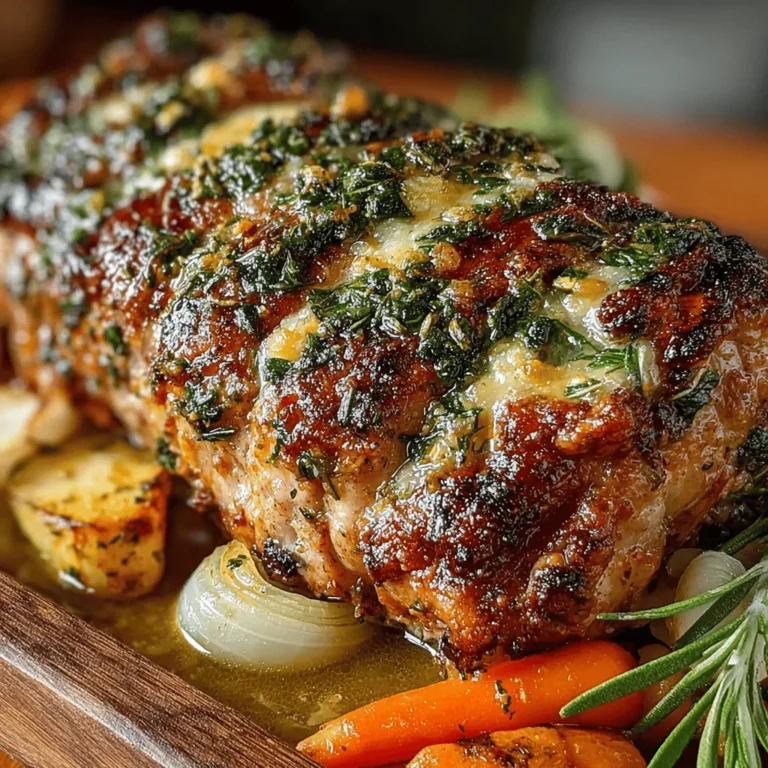Turkey has long been a centerpiece of special occasions and family gatherings, often synonymous with festive celebrations. This Herb Butter Roasted Turkey Breast recipe offers a delicious and flavorful alternative to traditional turkey preparations, perfect for both small gatherings and intimate dinners. By using fresh herbs and butter, this recipe enhances the flavor and juiciness of the turkey, making it a standout dish that everyone will love.
Ingredients
– 1 bone-in, skin-on turkey breast (about 4-6 pounds)
– 1/2 cup unsalted butter, softened
– 2 tablespoons fresh rosemary, chopped
– 2 tablespoons fresh thyme, chopped
– 2 tablespoons fresh sage, chopped
– Zest and juice of 1 lemon
– Salt and black pepper, to taste
– 1 cup low-sodium chicken broth
– 1 onion, quartered
– 2 carrots, cut into large chunks
– 2 celery stalks, cut into large chunks
Instructions
1. Preheat your oven to 375°F (190°C).
2. In a mixing bowl, combine the softened butter, chopped rosemary, thyme, sage, lemon zest, and lemon juice. Mix well until the herbs are evenly incorporated into the butter.
3. Pat the turkey breast dry with paper towels to remove excess moisture, which helps achieve a crispy skin.
4. Carefully loosen the skin of the turkey breast by gently inserting your fingers between the skin and the meat. Be careful not to tear the skin.
5. Spread half of the herb butter mixture directly under the skin, making sure to distribute it evenly for maximum flavor.
6. Rub the remaining herb butter all over the outside of the turkey breast, ensuring an even coating. Season generously with salt and black pepper.
7. In a large roasting pan, place the quartered onion, carrots, and celery to create a flavorful base for the turkey.
8. Place the prepared turkey breast on top of the vegetables in the roasting pan.
9. Pour the low-sodium chicken broth into the pan, surrounding the turkey but not pouring it directly on top.
10. Roast the turkey in the preheated oven for about 1.5 to 2 hours, or until the internal temperature reaches 165°F (74°C). Baste the turkey with pan juices every 30 minutes for added moisture.
Understanding the Ingredients
The ingredients in this Herb Butter Roasted Turkey Breast recipe play crucial roles in achieving a flavorful and moist dish. The choice of a bone-in, skin-on turkey breast is vital, as the bones and skin help retain moisture and add flavor during the roasting process.
Using unsalted butter allows for better control over the salt levels in the dish while enhancing the overall taste. Fresh herbs such as rosemary, thyme, and sage not only provide a fragrant aroma but also infuse the turkey with a depth of flavor that is irresistible.
Adding lemon zest and juice brightens the flavors, cutting through the richness of the butter and providing a refreshing contrast. The inclusion of low-sodium chicken broth is essential for keeping the turkey moist during roasting, preventing it from drying out and ensuring juicy slices.
Finally, the aromatics—onion, carrots, and celery—serve as a flavorful base in the roasting pan, enhancing the overall taste of the turkey and the drippings that can be used for gravy or sauce.
Step-by-Step Guide to Preparing Herb Butter Roasted Turkey Breast
To get started on this delectable dish, it’s important to prepare your kitchen and gather the necessary tools. You will need a roasting pan, a mixing bowl, a spoon for mixing, and a meat thermometer for checking the turkey’s doneness.
Begin by preparing the herb butter. In a mixing bowl, combine the softened butter with the fresh herbs, lemon zest, and juice. The key here is to ensure that the herbs are well distributed throughout the butter, which enhances the flavor profile of the turkey.
When it comes to preparing the turkey breast, it is crucial to pat the surface dry. This step is essential for achieving that coveted crispy skin. Next, gently loosen the skin to allow for the herb butter to be spread underneath, which will infuse the meat with flavor and moisture while it cooks.
Once the turkey is fully prepared and coated with the herb butter, it’s time to move on to the roasting process.

Tips for Achieving an Even Coating
To ensure that your herb butter is evenly distributed under the skin and on the surface of the turkey breast, follow these tips:
Use Softened Butter
Make sure the herb butter is softened but not melted. This allows you to spread it easily without tearing the skin.
Careful Application
Gently lift the skin away from the meat with your fingers, taking care not to tear it. Use a spatula or your hands to spread the herb butter evenly underneath the skin.
Massage the Surface
After applying the butter underneath, rub any remaining butter on the surface of the turkey breast. This creates a flavorful crust while roasting.
Preparing the Roasting Pan
Choosing the Right Vegetables
Select vegetables that will enhance the flavor of the turkey and absorb its juices during cooking. Carrots, onions, and celery are great options.
Arranging the Vegetables
Scatter the vegetables in a single layer at the bottom of the roasting pan. This not only flavors the turkey but also helps create a natural rack, allowing heat circulation around the meat.
Roasting the Turkey
Roasting Times and Checking Doneness
For a perfectly roasted turkey breast, the general rule is to cook it for 20 minutes per pound at 350°F (175°C). Always check the internal temperature using a meat thermometer; the turkey is safe to eat once it reaches 165°F (74°C).
Importance of Basting
Basting the turkey breast every 30 minutes with the pan juices will enhance moisture retention, resulting in a succulent final product. This process allows the herb butter to infuse deeper flavors into the meat.
Resting the Turkey
Why Resting is Crucial
Allowing the turkey breast to rest for at least 15-20 minutes after roasting is essential. This step lets the juices redistribute throughout the meat, ensuring every slice is juicy and flavorful.
Carving and Serving
Suggestions for Presentation
Once rested, carve the turkey breast against the grain for tender slices. Arrange the slices artistically on a platter, garnished with fresh herbs for a beautiful presentation.
Serving with Sides
Pair the turkey with traditional sides such as mashed potatoes, cranberry sauce, and green beans. A light salad or bread rolls can also complement the meal, creating a balanced dining experience.
Flavor Enhancements and Variations
Exploring Different Herbs and Spices
Feel free to experiment with various herbs like rosemary, sage, or thyme to create unique flavor profiles. Adding spices such as paprika or garlic powder can enhance the taste further.
Flavor Pairings and Side Dishes
Consider serving the turkey with apple sauce, cornbread stuffing, or roasted Brussels sprouts for added depth. The sweet and savory combinations will elevate your meal.
Brining or Marinating Options
For an extra layer of flavor, consider brining the turkey breast overnight in a mixture of water, salt, and your choice of herbs. This method helps to keep the meat moist and flavorful.
Nutritional Information
Nutritional Benefits of Turkey Breast
Turkey breast is a lean source of protein, low in fat, and rich in vitamins and minerals, including B vitamins and selenium. Pairing it with vegetables adds fiber and essential nutrients.
Portion Sizes and Serving Suggestions
A typical serving size for turkey breast is about 3-4 ounces, which can be accompanied by a variety of side dishes for a well-rounded meal. Balancing protein with vegetables and grains contributes to a healthy diet.
Conclusion
The Herb Butter Roasted Turkey Breast recipe is a simple yet delicious option for family gatherings or special occasions. With its rich flavors and easy preparation, it’s a perfect centerpiece for your holiday table. Using fresh ingredients will enhance the overall taste and experience, making every bite memorable. Embrace the joy of homemade meals and share this delightful dish with your loved ones.


